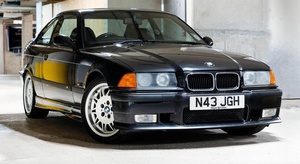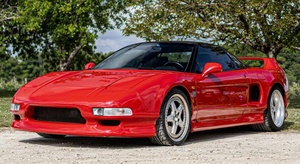
The first time I went to a British
Motor Trade Association meeting,
some ten years ago, much of
the conversation centered around the
poor quality of some of the aftermarket
parts that were being produced for our
beloved old cars. I have to confess, my
initial reaction was bored skepticism. I
figure…
Read the rest of the story

Gary
Dork
7/27/15 8:45 a.m.
A couple recent examples of aftermarket parts frustration I had with my '68 Spitfire:
-
Flex brake hoses to the front calipers and the rear wheel cylinders should have a square shoulder on the crimped fittings so the copper washer will seal the connection. This set had a 45-degree taper on the shoulder, so they were never going to seal. Had to re-source the hoses from a different supplier and got the correct parts the second time around.
-
Hard hydraulic line from the clutch master cylinder to the slave cylinder should have a bubble/45-degree flare on each end. This one came with a double flare on each end. Never going to work. Fortunately I have the capability to re-do the ends with the correct flare, but shouldn't have had to.
In both of these cases I blame the direct supplier who I purchased the parts from for not properly specifying the requirements to their supplier. Other than incorrect spec, the quality of manufacture was acceptable. In fact, the hard line for the clutch hydraulics was made in the UK, and was excellent quality, but just the wrong flare for the application.
As you say, awareness is important. Enter the enthusiast's forum. Talk about parts on-line and often and the vendors will begin to source and supply better parts. We went through this change over the past 10 years in the Fiat 124 community.

In my previous career, I worked at a British car shop selling parts. We had three or four major suppliers and a handful of smaller suppliers. We always tried to keep the best parts on the shelf, but unfortunately when something good quality wasn't available we would stock the inferior parts just so that people who desperately wanted said part could have them. There were countless times that a supplier would switch sources on parts, and these would either fall apart in your hand or give up the ghost within months of installing them. In defense of the supplier switching manufacturers, the supplier had to make money, us the middle man wanted to make money, and the customer didn't want to spend money. So, we would ask our supplier for a cheaper price, the supplier would look for cheaper sources etc. I had numerous customers complain about inferior products, one example was an Austin Healey owner who complained that the $4 ignition rotor he bought 6 months before had gone bad (cracked bakelite/plastic where the rivet held the contact causing arcing). I explained to him that we did have a better quality one (no rivet and made from a better quality plastic) but it was roughly twice the price, he refused to buy it because "rotors should be $4 not $8". I then explained to him that if he really does want quality parts, they cost more, but again that fell on deaf ears. He was always ordering chrome trim items and always complaining about them, but what should you expect when a small piece costs $15 yet to have the original re-plated costs $50?
The shop also had a service department, so we knew, somewhat, first hand which parts were good and which parts were garbage. This at least allowed us to stock what worked, but a lot of times the customer either complained about the price or went elsewhere.
I really hate to say it, but most people are too cheap (myself included, though I prefer to fabricate my own parts rather then shell out big money), this is the major reason for cheap inferior parts. But, in saying that, the retail suppliers should know what they're selling and should keep an eye on what works and what doesn't.
Eventually I was fed up with the parts business and moved onto a better career.
Gary,
Was the pipe made by Automec? If so, they never seemed to fabricate the pipes correctly. I don't know why we stocked them, nor why Moss etc stocked them. I had to remake pipes over and over again for customers who had issues with them. In the end we really should have made the pipe sets in house.
Rod
I think a lot of this stems from an almost constant flow of quality factory parts...and then nothing. The factory sources dry up, leaving aftermarket parts the only option, and many trying to undercut the factory pricing we were used to due to customer demand. I know I would pay a bit more for a factory part, but thought all aftermarket parts should be cheaper. In truth, a quality part simply costs more to produce. As stated above, we created this problem among ourselves to a large degree. I first started noticing this back when I had Alfas, and really noticed it the 3rd time I replaced my X1/9 master cylinder.
The truth is, if as customers we paid more and demanded better parts, they would exist. Vendors usually want to sell what their customers want and will pay for. Quality and cheap don't normally go together. The fact that many of our cars were cheap themselves for so long added to the problem too.

The upshot of driving an old, collectible car is there are generally communities for enthusiasts to compare experiences. For example, Barney at MGAGuru maintains a faulty parts list. If I'm buying an MGA grille or something, I look there to see what and what not to buy. Below is a photo of the currently available MGA badge. What makes Barney's site so good is that it has pictures. You could read "Do not buy. It's a machine screw cold-soldered to the badge" and maybe still take the chance, but actually seeing how poorly some of these parts are made should make you think twice. Eventually the retailers take note and many times a new supplier is found. Not necessarily the best way to get quality replacement parts, but it's better that paying for trash.
On the other hand, for old Land Rovers, places like Rovers North offer a "Genuine" part along side the cheaper "ProLine" part, which is a lesser part sourced from an undefined aftermarket supplier. I wish the MG/AH/TR retailers offered such a thing - "Here's some brake pads that work and here's some cheaper ones that might also work."


Gary
Dork
7/27/15 12:15 p.m.
In reply to RoddyMac17:
I purchased the parts through a well known domestic supply house in the Midwest that's been in the business for decades. I'm not sure who the UK manufacturer of the hydraulic line was, but it was Cunifer material (great stuff to work with, by the way), and I'm 99% sure of which type of flaring tool was used (i.e., the excellent British-made tool). There were other clues that it was a UK product, but not the specific manufacturer. As I said, the quality of the part was excellent, just the wrong type flare for '68 Spitfire master and slave cylinders. So that's the direct U.S. supplier's fault for either not specifying the part correctly, or failing to perform incoming inspection on their sourced parts ... or perhaps they were just clueless about what type of flare was required in the first place and simply took what their supplier gave them as being correct for the application. If that's the case, shame on them.
(Regarding the flex lines that didn't work, I bought another set, but this time from the people in Lincoln, CA. That set was good).
Incidentally, I had a great conversation yesterday with a fellow Spitfire owner at Day of Triumph (Larz Anderson Museum lawn event). He only uses parts purchased from the big, well known parts supplier in the UK. He says he pays a bit more due to the x-rate and shipping, but he's never been burned with a bad part.
i taught at a technical/vocational college level school in Daytona FL. auto classes.
one thing i instilled to the serious students was, many times the quality of your work will be limited by your parts supplier and the quality of his available products!
Great comments, guys! Glad I could spark some dialog on the subject.





























